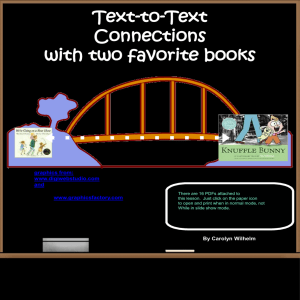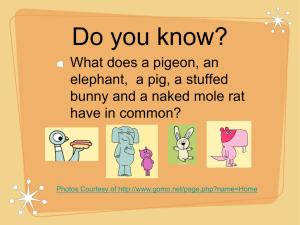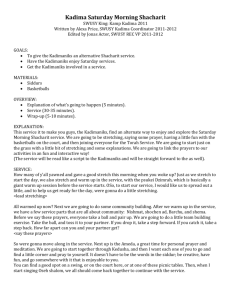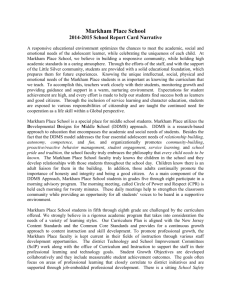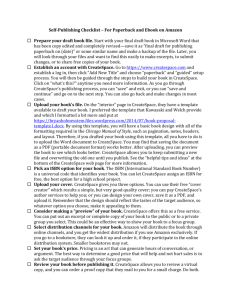File - Manitoba Writing Project
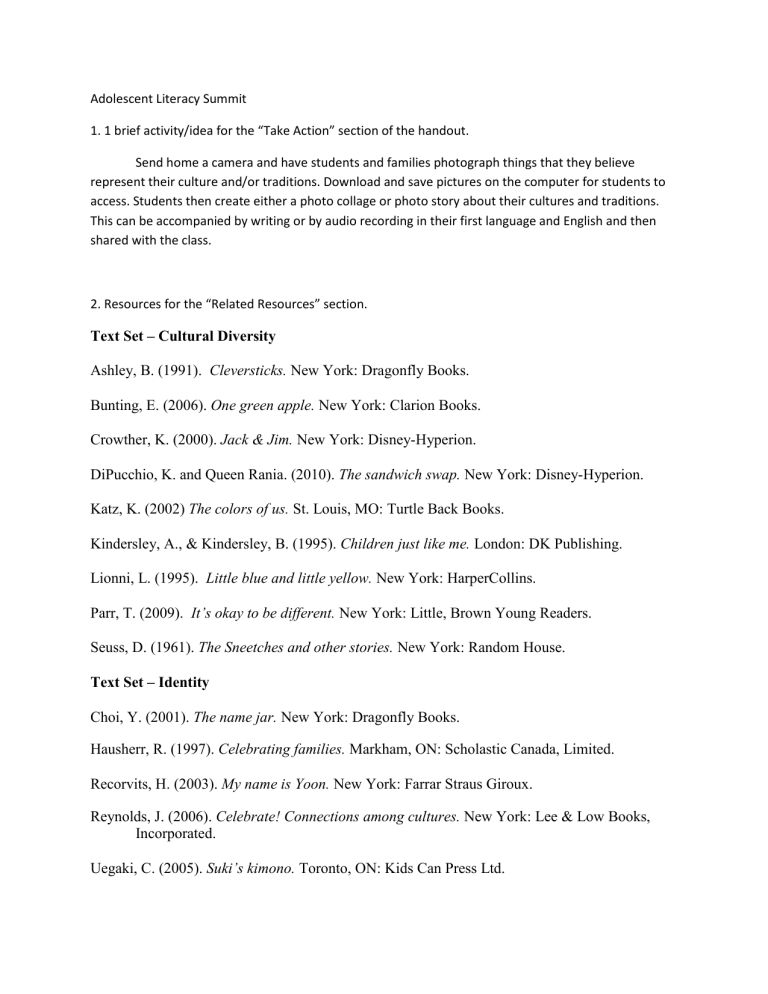
Adolescent Literacy Summit
1. 1 brief activity/idea for the “Take Action” section of the handout.
Send home a camera and have students and families photograph things that they believe represent their culture and/or traditions. Download and save pictures on the computer for students to access. Students then create either a photo collage or photo story about their cultures and traditions.
This can be accompanied by writing or by audio recording in their first language and English and then shared with the class.
2. Resources for the “Related Resources” section.
Text Set – Cultural Diversity
Ashley, B. (1991). Cleversticks. New York: Dragonfly Books.
Bunting, E. (2006). One green apple.
New York: Clarion Books.
Crowther, K. (2000). Jack & Jim.
New York: Disney-Hyperion.
DiPucchio, K. and Queen Rania. (2010). The sandwich swap.
New York: Disney-Hyperion.
Katz, K. (2002) The colors of us.
St. Louis, MO: Turtle Back Books.
Kindersley, A., & Kindersley, B. (1995). Children just like me.
London: DK Publishing.
Lionni, L. (1995). Little blue and little yellow. New York: HarperCollins.
Parr, T. (2009).
It’s okay to be different.
New York: Little, Brown Young Readers.
Seuss, D. (1961). The Sneetches and other stories.
New York: Random House.
Text Set – Identity
Choi, Y. (2001). The name jar. New York: Dragonfly Books.
Hausherr, R. (1997). Celebrating families.
Markham, ON: Scholastic Canada, Limited.
Recorvits, H. (2003). My name is Yoon. New York: Farrar Straus Giroux.
Reynolds, J. (2006). Celebrate! Connections among cultures. New York: Lee & Low Books,
Incorporated.
Uegaki, C. (2005).
Suki’s kimono.
Toronto, ON: Kids Can Press Ltd.
Yamaguchi, K. (2011). Dream big, little pig.
Naperville, IL: Sourcebooks, Inc.
Text Set – Dual Language
Bouchard, D (2006). Nokum is my teacher.
Markham, ON: Red Deer Press.
Highway, T. (2013). Caribou song.
Markham, ON: Fifth House Ltd.
Jaramillo, N.P. (1996).
Grandmother’s nursery rhymes/Las nanas de abuelita.
New York:
Macmillan.
Johnson, T. (2012). Bosley sees the world/Bosley decouvre le monde.
The Language Bear
*These books can be found in many dual languages, such as: English-German, English-
Russian, English-Spanish, English-Chinese, and English-Arabic.
Johnson, T. (2013). Bosley goes to the beach/Bosley va a la plage.
CreateSpace Independent
Publishing Platform.
Romulo, L. (2006). Filipino friends.
North Clarendon, VT: Tuttle Publishing.
Winterberg, P., & Wichman, N. (2013). Am I small? Kl maim niki ham?
CreateSpace
Independent Publishing Platform.
Book Set – Knuffle Bunny
Willems, M. (2004). Knuffle bunny: A cautionary tale.
New York: Hyperion Books.
Willems, M. (2007). Knuffle bunny too: A case of mistaken identity.
New York: Hyperion
Books.
Websites
(2014, July 22) Alphabet Kids. Retrieved from www.alphabetkids.com/
(2014, July 22) Bright Books. Retrieved from www.brightbooks.co.uk
(2014, July 22) Language Lizard. Retrieved from www.languagelizard.com
Academic Readings
Ada, A.F. & Campoy, F.I. (2004). Authors in the classroom. A transformative education
Process. Person Education, Inc. United States.
Campano, G. (2007). Honouring student stories. Educational Leadership, 65(2), 48-54.
Christensen, L. (2009). Introduction (1-11). Teaching joy and justice: Re-imagining the language
arts classroom. Milwaukee, WI: Rethinking schools.
Comber, B, (2013). Schools as meeting places: Critical and inclusive literacies in changing local environments. Language Arts, 90(5), 361-375.
Cummins, J. & Early, M. (2011). Identity texts. The collaborative creation of power in
multilingual schools. Trentham Books: UK.
Dragan, P.B. (2008). Kids, cameras, and the curriculum. Portsmouth, NH: Heinemann.
Giampapa, F. (2010). Multiliteracies, pedagogy and identities: Teacher and student voices from a Toronto elementary school. Canadian Journal of Education, 33(2), 407-431.
Janks, H. (2014). Introduction (1-10). Doing critical literacy: Texts and activities for students and
teachers. New York: Routledge.
Jones, S. (2014). Assembling a critical pedagogy: On writing selves and other selves out of bindedness: Toward beauty and grace. In S. Jones (Ed.), Writing and teaching to change
the world: Connecting our most vulnerable student (1-14; 123-131). New York: Teachers
College Press.
Lewison, M. & Heffernan, L. (2008). Rewriting writers workshop: creating safe spaces for
Disruptive stories. Research in the Teaching of English, 42(4).
Nieto, S. (2008). Culture and education. In D.L. Coulter, & J.R. Wiens (Eds.), Why do we educate?
Renewing the conversation. 107 th yearbook of the National Society for the Study of
Education (pp. 128-142). Massachusetts: Blackwell Publishing Malden.
Tan, A. (2008, February 6). Mother tongue. [Blog post: Home is where the heart dwells].
Retrieved from
http://blogs.law.harvard.edu/guorui/2008/02/06/mother-tongue-by-amy-tan/
3. Brief outline of my talk.
Last June a student of mine made the comment “you’re nothing but an Indian” to another student in my class. This comment shocked me and when I asked this student why she had said this, she told me that that is what her parents say at home. I realized then that I can have all the conversations I want with my students, but that there was no guarantee that what we were learning and talking about were making it past the walls of the school and into the homes of my students.
This comment, plus some ‘light’ summer reading, led me to plan a writing project that would extend past the classroom and into the homes of my students. Students and their families spent time with the Knuffle Bunny (after reading the stories) and wrote about their culture, traditions, beliefs, and customs in their first languages in a journal and took pictures of this to accompany the written piece.
This journal allowed parents and students to showcase and write about what they felt was important to them and their cultures and was designed to show that no language was privileged more than another.
As students sent in their journals and pictures we shared them with the class, allowing for conversations and observations to happen.
Each journal was translated into all of the different languages present in our classroom and then we created a multilingual book that is being published through McNally, which features all of the different stories, languages and pictures of my students’ families. This book will be sent home to families to read and learn about the different cultures in their child’s classroom.
Noticed observations include impromptu visits from families to the classroom to share stories about their cultures and traditions, parents who don’t normally talk chatting after school, and parents and students noting similarities amongst each other.


